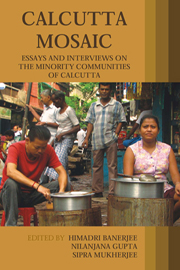Book contents
- Frontmatter
- Contents
- List of Contributors
- Acknowledgements
- Introduction
- 1 Mapping the Spaces of Minorities
- 2 The Armenians of Calcutta
- 3 The Jews of Calcutta: An Interview with Michael Ezra
- 4 The Sindhis of Calcutta
- 5 The City of Colleges
- 6 The Chinese Community of Calcutta
- 7 The Anglo–Indians of Calcutta
- 8 The Biharis of Calcutta
- 9 Agraharis of Calcutta
- 10 A Journey into My Neighbourhood
- 11 The ‘South Indians’ of Calcutta: Experiences in Cultural Processes
- 12 ‘Non-Bengali’ Icons of Malevolence
- 13 Selfing the City
11 - The ‘South Indians’ of Calcutta: Experiences in Cultural Processes
Published online by Cambridge University Press: 05 March 2012
- Frontmatter
- Contents
- List of Contributors
- Acknowledgements
- Introduction
- 1 Mapping the Spaces of Minorities
- 2 The Armenians of Calcutta
- 3 The Jews of Calcutta: An Interview with Michael Ezra
- 4 The Sindhis of Calcutta
- 5 The City of Colleges
- 6 The Chinese Community of Calcutta
- 7 The Anglo–Indians of Calcutta
- 8 The Biharis of Calcutta
- 9 Agraharis of Calcutta
- 10 A Journey into My Neighbourhood
- 11 The ‘South Indians’ of Calcutta: Experiences in Cultural Processes
- 12 ‘Non-Bengali’ Icons of Malevolence
- 13 Selfing the City
Summary
Much of the infrastructure and general atmosphere of Calcutta is heir to the colonial institutions and the mentality born out of colonial history. As a cosmopolitan city Calcutta experiences the presence of a sizeable section of people from other provinces of India. These people from other ethnolinguistic backgrounds migrated here in the nineteenth and twentieth centuries. This mixed composition staying away from their homelands are usually clubbed together by the Calcuttan under a common blanket term – ‘non-Bengalis’. Of these non-Bengalis, a sizeable section belongs to the different South Indian communities. To begin with, let us admit a common misnomer or a faulty identification of all South Indian people as ‘Madrasis’. E M S Nambudiripad's reaction to the use of such a loose term was:
The Madrasi, or the South Indian, is in the eyes of an ordinary North-Indian, one type of Indian, just like the Bengali, the Punjabi etc. The entire people of Madras or South India are to them the same.
This common mistake has a historical reason probably. The temporary or permanent migration from different South Indian provinces to different parts of Northern India began with the colonial governance. At that time, all the officials or functionaries from any of the four South Indian provinces represented the ‘Madras Presidency’. The use of such a mistaken blanket term is outdated now and it is the rather loosely-bound, though at least geographically correct term, the ‘South Indian’, which still remains in vogue.
- Type
- Chapter
- Information
- Calcutta MosaicEssays and Interviews on the Minority Communities of Calcutta, pp. 211 - 230Publisher: Anthem PressPrint publication year: 2009



